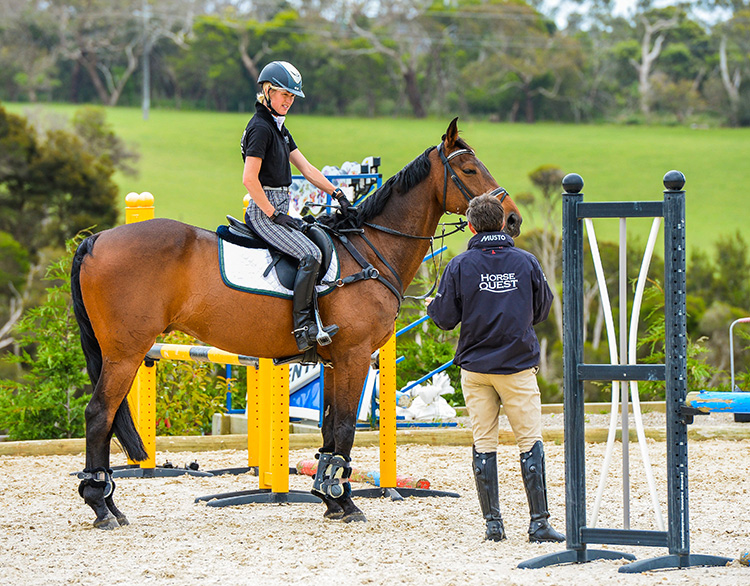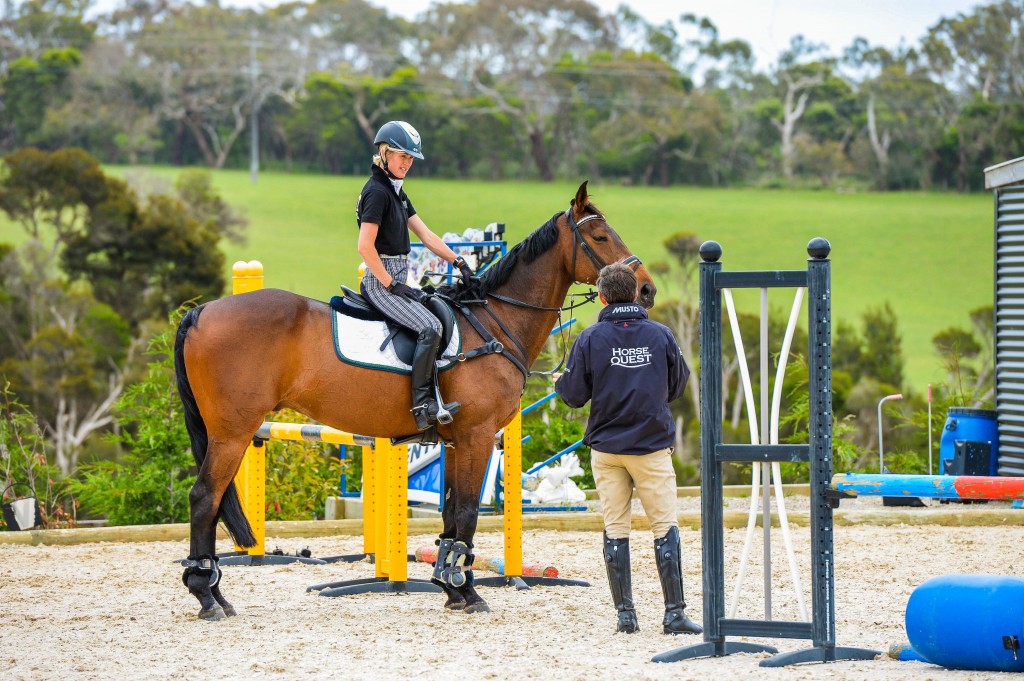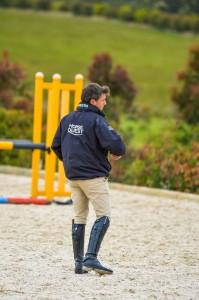Story by Susan Mackenzie & Photos by Roz Neave
The day at Sara Madden’s Fairhurst started with Sam instructing in the art of showjumping, focusing on position and connection, drilling home the importance of this phase in the safe confines of the arena. After lunch he headed to the extensive cross-country course with the mixed bunch of riders, insisting that all the principles of cross-country riding are the same, the jumps just get bigger as you move up the grades…
When Roz and I arrive Jenny Hodgins is having a lesson with Sam on Ollie (aka Lamborne Park Teacher’s Pet) Sam laughs that his teaching method will be under scrutiny as not only is Jenny a teacher, but both her parents, who have come to watch the clinic, taught Sam at his old school.
The horse is 14 years old and has been doing 2*, progressing to 3*.
“You’ve got him nicely trained but he catches you by surprise and spooks, you need more pressure in the rein; you get too loose and lose the communication.”
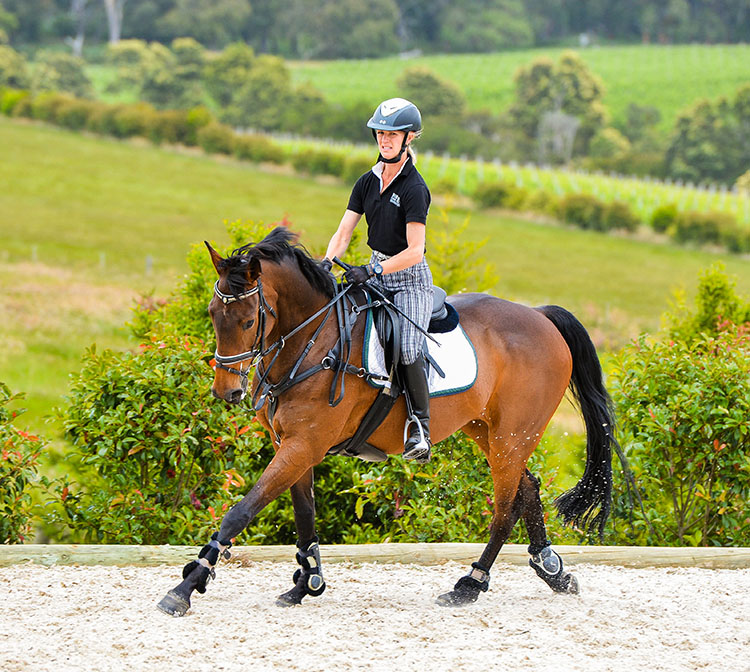
Sam has a very relaxed teaching style, he is quick to notice things and adjust the rider but he also gives them time to sort things out themselves. While he might have been over in the UK for quite some time Sam still has his laid back Aussie approach; keeping it simple, but getting results.
“If you take a bit more rein you’ll feel him go rigid before he spooks and be able to prevent it.”
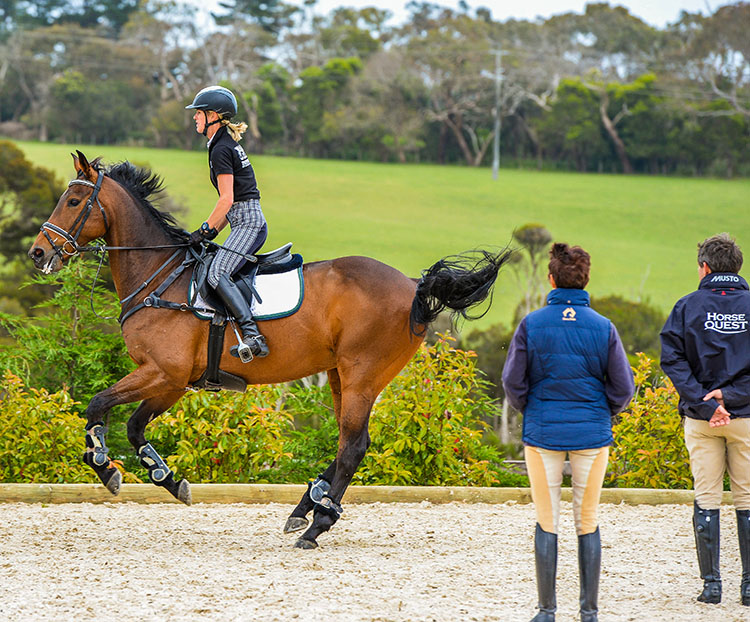
“You keep your hands down nicely but you keep your knee on a bit too much. It’s important that we don’t grip with the knee, this blocks their ribs and shoulders. Taking your knee off gives a better balance and puts the leg in the ‘ready position’. If you’re gripping with your knee your lower leg comes off.”
Jenny does another lap of the arena and this time she pulls her knee off, hugs with her lower leg, pulls her upper body up and keeps a better connection with her rein; the horse is already looking a lot better and Jenny looking more secure.
“There, you caught him before he spooked, well done.”
They try some poles and it’s a bit messy; the horse loses his balance and bangs his way through.
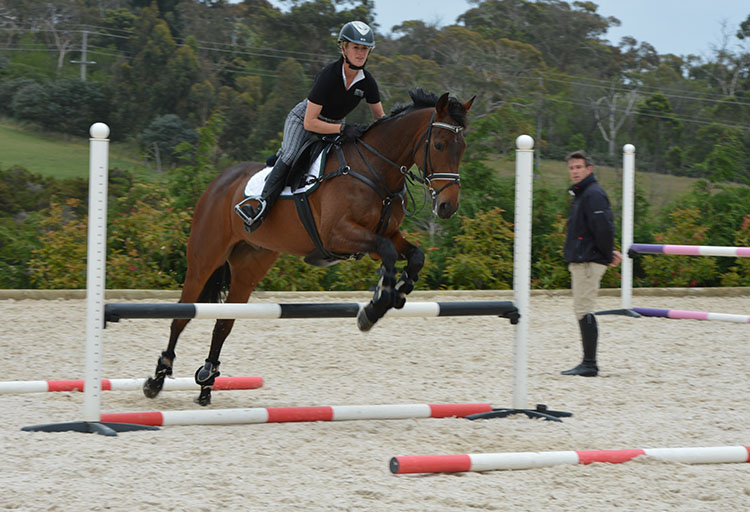
“He’s going too ‘dressagey’ at the moment, you need a bigger canter, but at the same time you need to make sure you keep his shoulders up more on the corners. He had to change balance before the poles, we want him already in that position.”
As they start the fences Sam is quick to note that Jenny’s knee is rolling on again, the habit is there, but corrects this and looks much more balanced, in turn balancing the horse.
The horse gets upset doing the changes between fences; Sam is quick with the correction:
“Don’t think ‘oh I missed it’, and then ask, ask, ask. What I do is go, ‘oh I missed the change’, then I go one, two, three, change. Let him get settled again.”
“Your balance is good, your left leg is good, but your right… I’m not sure what you’re doing so let’s get you out of the saddle around the arena then sitting back down at the jumps. We want to get more balanced, focusing on a relaxed knee, sitting back so he doesn’t get too long in the canter.”
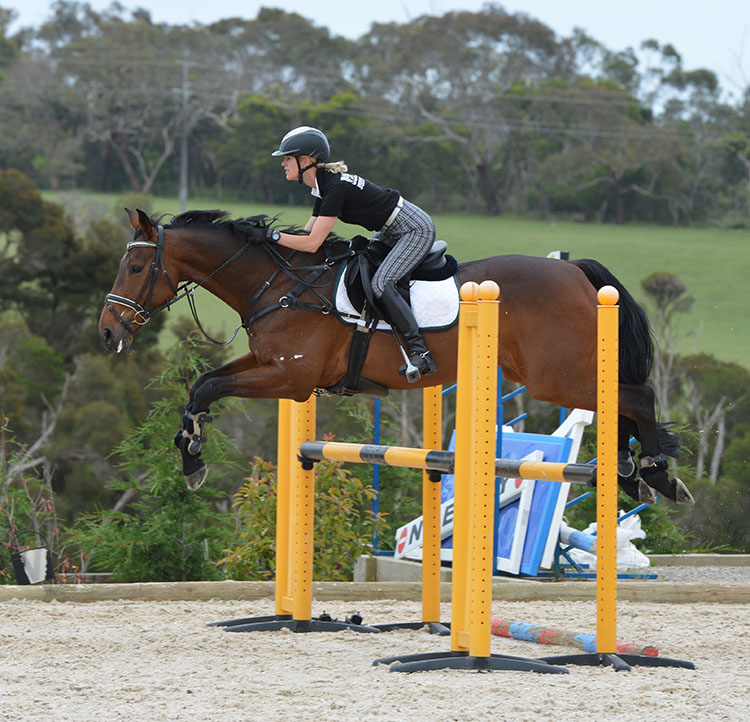
“As I’m getting to know you as a combination I can see he gets too long in the body, but as you get him up he is getting better.”
Sam sets up a pole in front of a small cross rail then five strides to a rather spooky yellow upright. The horse jumps through but is crooked, and thinks it’s time to change when Jenny isn’t asking him to.
“Imagine that you’re cantering down a centre line and there’s a dressage judge in front of you. You need the horse straight so that they can get their legs underneath them properly.”
“Imagine his hind legs as two engines so when they’re crooked it’s not that he jumps more from one hind leg than the other, but it’s that he jumps less off one so you lose power. So keep him straight with both those engines firing.”
Sam adds two poles after the upright to help keep the horse straight, it’s better.
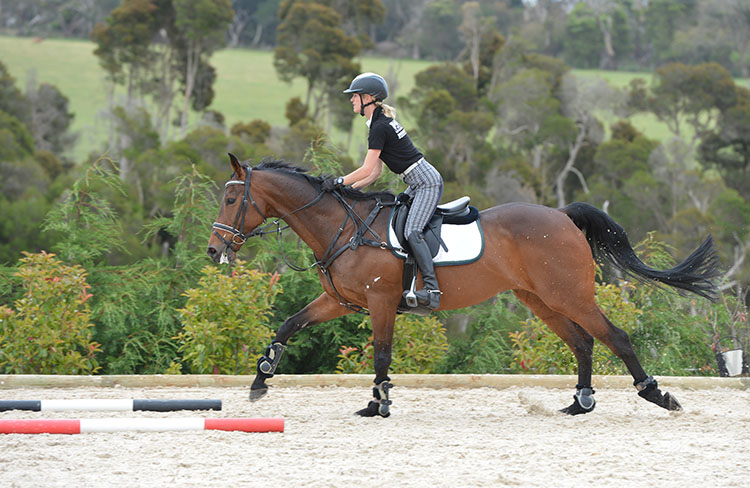
Jenny says that she is worried about the striding, that it could be 6 not 5.
“If you’re worried about striding,” says Sam, “you need to get the striding on the first or second stride after the first jump, or even before the jump, not in the last few strides to the second jump.”
Sam adds another fence after the upright, an oxer after a sweeping left turn, the horse gets crooked and buries his shoulder, knocking the fence.
“He only knocked that because he was crooked on the turn and lost his power, keep his balance up on the corner. Because he dives into that shoulder it means he will have to change his balance before the jump and lose power.”
The horse is getting long again, “he needs to be more of a spring, so relax the knee, sit back, keep the communication in the rein and think of his balance.” Third time is better.
Sam adds in some more jumps to make a course of five.
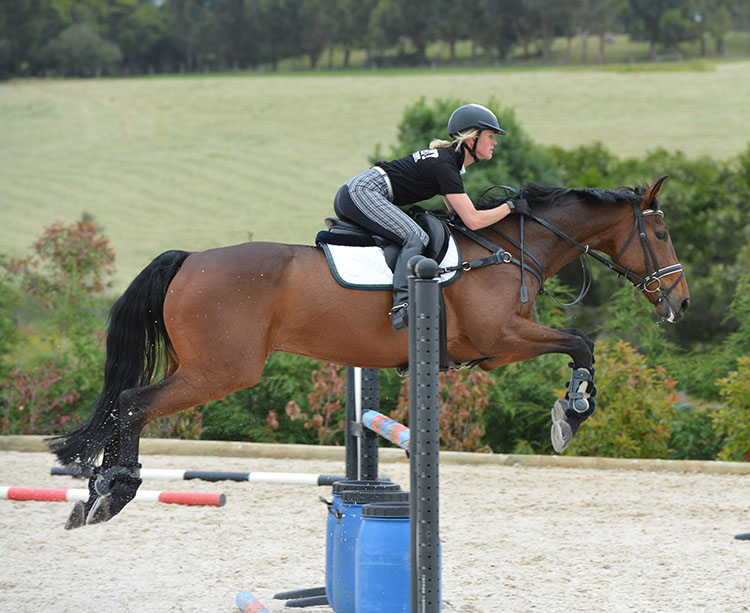
“Can you see what he does with his balance between fences, he’s going too ‘dressagey’ on you. I’d like to see you get distances earlier. Over that last jump you wanted to land on the correct leg, so your bum went sideways in the air, he can do changes so think of riding straight to the end of the arena then changing.”
“He’s getting too long all the time, think of him as a spring, get that lower leg on, knee relaxed.”
“The legs create the energy, the hands capture it.”
The third time round is better, but the horse is a bit wriggly, “the main thing this guy needs to work on is straightness, so always have side poles, and if you’re jumping striped jumps you have to aim at a stripe, don’t let him decide.”
The second lesson is a complete mixed bag, but Sam is quite unfazed by it all, switching between calming down one horse and rider combination who are tearing around the arena with the horse looking scared and confused and waking up the other combination where it seems the horse has perfected his technique of sleep-jumping…
With the over-excited bay horse Sam gets his rider, Shannon Caitlan to alter the horse’s speed within the gait, “you need to get him a bit more manageable, within the pace speed up a little, and then slow down a little. Do it in trot and canter. Not big changes, just little. He needs to accept you and accept your leg more. Little changes of pace so that he starts respecting you.”
“Rise over your knees and keep your legs steady.”
The rider of the sleepy chestnut, Sarah Salmon, receives the same focus on having soft knees as the previous rider, Jenny:
“Your big thing is being loose in the knees, you need to loosen up there. When we’re jumping the only thing that keeps us in the saddle is our leg. If you have a good solid foundation you can control your body better.”
“Anyone who has position problems you can trace back to the leg. You’ll hate me tomorrow because your calves will really hurt!”
“So stand up, take your knee off then sit back down in your dressage position but with your knees the same. Toe out a little, not too far or you’ll put the spur in. As a straight showjumper I might do toe in more, but as eventers we go up and down hills and through water so you need the stability there with the toe out a little.”
Sarah finds it strange: “it feels a bit insecure, but I think it’s just because I’m not used to it.” They do a few laps and you can see the difference, and Sarah is happy, “It’s a lot easier to sit into the saddle as I’m not getting pulled forward.”
Sam laughs and agrees, “In dressage all your weight is in your seat so that you can manoeuvre your legs. In eventing, like I said, once your bum is out of the saddle then you’re relying completely on your legs.”
The soporific chestnut is rudely awoken as his rider, with her newfound balance through her soft knee and secure lower leg gets him moving, and as the jumps go up he proves that he can jump. Sam works on getting the canter springier, “you’ll need to get him more forward from your leg, not from your seat.”
Multi-tasking Sam then goes back to the hot little bay who is so exuberant that a simple turn to the trotting poles has him scooting around. “Right, he’s getting upset on the corner to the poles, so come around in canter then halt before the poles then walk through.”
“He’s looking at the poles too early, he needs to stay even, as you come around the corner look at the poles, then look away and then back again, not letting the horse focus on the jump.”
“Stop seeing the stride too early and get him balanced before the fence.”
“He’s a sensitive little fella isn’t he,” says diplomatic Sam.
The bay takes off after the fence and spooks at anything he can see, “part of it is slowing his brain down because he’s seeing everything right now, so you keep him straight after the jump and focus on straight, not too strong in the hand. If you keep saying things with your hand he’s going to get confused, just sit there normally, sit there.”
“After the jump I want you to stop him, but standing in your stirrups, once he is stopped then you can sit down again, otherwise all the horse is going to think is, ‘after we jump we go’.”
“It’s contrary to dressage, but it lets him bring his back up and bring his legs underneath him, you’ve got to slow this horse’s brain down, it’s going a million miles an hour.”
“It’s important to keep him smooth and balanced, with the right strides so you don’t give him anything else to think about, anything else to get upset by – he hit a rail there and that sent his brain into overdrive.”
By the end of the lesson the bay stands more or less still, anxiety lessened, the chestnut looks less like a big pony and is now wide awake!
Next month we’ll pick up Sam’s lesson again, this time on cross country…


